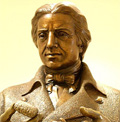Part 2: Jenner’s breakthrough
In this four-part series, we look at the history of vaccination and how it has shaped public health
 By the tail end of the 18th century, inducing immunity against smallpox through variolation had become relatively common among well-heeled Europeans.
By the tail end of the 18th century, inducing immunity against smallpox through variolation had become relatively common among well-heeled Europeans.
However, the practice was imperfect and sometimes dangerous. A safer and more effective method of inoculation was needed, as well as a deeper scientific understanding of the immunological mechanisms underlying this phenomenon.
Step forward Edward Jenner. An English country doctor with a keen interest in nature and science, Jenner’s contribution to public health can scarcely be understated. His work saved countless lives and set in train a medical revolution that has dramatically increase life expectancy and slashed infant mortality rates.
Jenner had observed that milk maids tended not to get smallpox and wondered whether the blisters they developed from cowpox protected them from smallpox. The two diseases are closely related, although cowpox is considerably less dangerous to humans.
In a landmark experiment in 1796, Jenner inoculated an eight-year-old boy named James Phipps with pus from a cowpox sore on the hand of Sarah Nelmes, a local milkmaid. He then repeatedly exposed the boy to smallpox.
His theory was that his young subject would be immune to smallpox following inoculation with cowpox. It was a radical and risky procedure – unlikely to find favour with contemporary research ethics committees – which could have killed James Phipps and destroyed Jenner. But it worked.
The boy endured a fever after infection with cowpox but recovered well and was then shown to be protected against smallpox. Significantly, Jenner went on to demonstrate that this immunisation could be achieved by inoculating from person to person rather than just from cow to human. Thus a much safer method for inoculation against smallpox had been devised and the modern era of vaccination had begun.
Not surprisingly, there was considerable wariness among the medical establishment which was initially unconvinced of Jenner’s genius. However, he would continue researching vaccination until his death in 1823.
News of Jenner’s breakthrough had reached the United States by the turn of the 19th century where it found such enthusiastic supporters as Thomas Jefferson. Variolation fell out of fashion and was replaced by vaccination – a term which Jenner says was coined by his friend Dr Richard Dunning. The term is derived from the Latin for cow (vacca).
Within a short period, the mortality rate from smallpox had declined significantly and the fledgling field of immunology broadened its attention to other diseases which plagued mankind.
Pasteur and progress
The principle of vaccination having been established and proven in smallpox, the next step was to apply this new method to other diseases. Jenner, the founding father of immunization, broke open a whole new branch of science but it would fall to a new generation of innovative thinkers to drive vaccination forward.
The undisputed leader of this revolution was Louis Pasteur, a French chemist and microbiologist, who became one of the most influential thinkers of the 19th century. Pasteur already had an impressive research career behind him by the time he turned his attention to immunology.
In 1879, he produced the first laboratory-developed vaccine as part of his efforts to immunize against chicken cholera. With a combination of ingenuity and good fortune, Pasteur attenuated (or weakened) the bacteria used in the vaccine – a major leap forward in reducing the risks associated with vaccines.
Pasteur’s efforts to understand the mechanisms behind deadly infections such as rabies or anthrax ultimately led him to develop vaccines against both in the 1880s. He also observed that the Streptococcus pneumoniae bacterium is responsible for pneumonia, meningitis, as well as other illnesses.
The Institut Pasteur was established in 1888 as a centre for research and rabies treatment. So profound was Pasteur’s influence on scientific knowledge that sister institutes began springing up in other locations to provide rabies vaccination. The Institut Pasteur now has a presence in 30 international locations and has 146 research institutes focusing on infectious diseases, public health and teaching.
This burst of activity at the close of the 19th century was soon followed by improvements in production of vaccines as well as new regulations on vaccine manufacturers in Europe and the US which helped improve safety.
Huge progress had been made but there remained much for 20th century scientists to do.
Sources:
www.historyofvaccines.org
Ian Glynn and Jenifer Glynn, The Life and Death of Smallpox
Matthew Maty, The Advantages of Early Inoculation
Michael B. A Oldstone, Viruses, Plagues, & History
This article is part of a series compiled by Vaccines Today to raise awareness of European Immunization Week 2011 which runs from 23-30 April





Jennylee
June 8th, 2011
Thanks for sharnig. Always good to find a real expert.